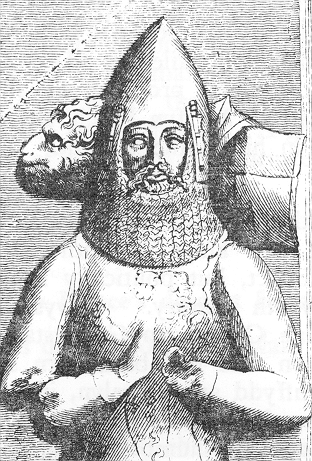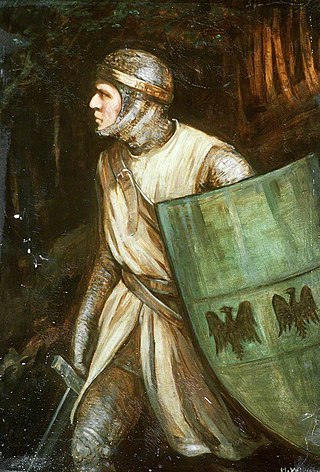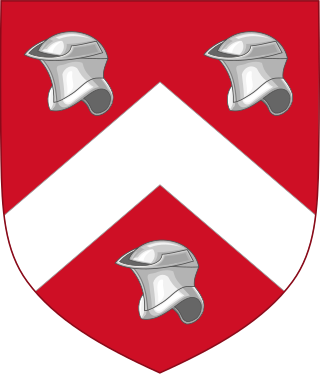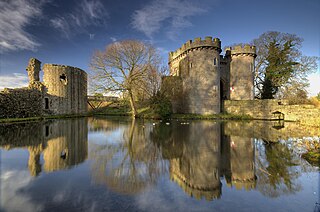Related Research Articles

Rhys ap Gruffydd or ap Gruffudd was the ruler of the kingdom of Deheubarth in south Wales from 1155 to 1197. Today, he is commonly known as The Lord Rhys, in Welsh Yr Arglwydd Rhys, although this title may have not been used in his lifetime. He usually used the title "Proprietary Prince of Deheubarth" or "Prince of South Wales", but two documents have been discovered in which he uses the title "Prince of Wales" or "Prince of the Welsh". Rhys was one of the most successful and powerful Welsh princes, and, after the death of Owain Gwynedd of Gwynedd in 1170, the dominant power in Wales.

Owain ap Gruffudd was King of Gwynedd, North Wales, from 1137 until his death in 1170, succeeding his father Gruffudd ap Cynan. He was called Owain the Great and the first to be styled "Prince of Wales", and the "Prince of the Welsh". He is considered to be the most successful of all the North Welsh princes prior to his grandson, Llywelyn the Great. He became known as Owain Gwynedd to distinguish him from the contemporary king of Powys Wenwynwyn, Owain ap Gruffydd ap Maredudd, who became known as Owain Cyfeiliog.

Sir Owen Tudor was a Welsh courtier and the second husband of Queen Catherine of Valois (1401–1437), widow of King Henry V of England. He was the grandfather of Henry VII, founder of the Tudor dynasty.

Ellesmere is a town in the civil parish of Ellesmere Urban, in Shropshire, England, located near the Welsh border and the towns of Oswestry and Whitchurch, and the Welsh city of Wrexham. It is notable for its proximity to a number of prominent meres.

Nesscliffe is a village in Shropshire, England, located north of the River Severn. The village comes under the Great Ness parish.

Myddle—also formerly known as Mydle, Middle, Midle, M'dle, Meadley and Medle—is a small village and former civil parish, now in the parish of Myddle, Broughton and Harmer Hill, in the Shropshire district, in the ceremonial county of Shropshire, England, about 10 miles north of Shrewsbury, the county town of Shropshire. In 1961 the parish had a population of 745.

Sir John Wynn, 1st Baronet, was a Welsh baronet, Member of Parliament and antiquary.

Great Ness and Little Ness are civil parishes in Shropshire, England.

Whittington Castle is a castle in northern Shropshire, England, owned and managed by the Whittington Castle Preservation Fund. The castle was originally a motte-and-bailey castle, but this was replaced in the 13th century by one with buildings around a courtyard whose exterior wall was the curtain wall of the inner bailey. As a castle of the Welsh Marches, it was built on the border of Wales and England very close to the historic fort of Old Oswestry.
This article is about the particular significance of the century 1201–1300 to Wales and its people.
Cadwallon ap Madog was the son of Madog ab Idnerth who had died in 1140, while Idnerth was a grandson of Elystan Glodrydd who had died in around 1010 and had founded a dynasty in the Middle Marches of Wales, in the area known as Rhwng Gwy a Hafren.
Roger Godberd was a medieval outlaw who has been suggested as a possible historical basis for the legend of Robin Hood. Some have suggested his life was the inspiration for the story of Robin Hood, though there is no solid evidence supporting this claim. Godberd’s criminal history is often compared with the Robin Hood legend since some minor details align with the famous story.

Anwyl of Tywyn are a Welsh family who claim a patrilinear descent from Owain Gwynedd, King of Gwynedd from 1137 to 1170 and a scion of the royal House of Aberffraw. The family motto is: Eryr eryrod Eryri, which translates as "The Eagle of the Eagles of Snowdonia. The family lives in Gwynedd and speak Welsh.

The Kynaston Baronetcy, of Hardwick and of Worthen in the County of Shropshire, was a title in the Baronetage of the United Kingdom. It was created on 3 October 1818 for John Kynaston Powell, of Hardwick, Shropshire, with remainder in failure of male issue of his own to his brother Edward Kynaston and the male issue of his body. He was born John Kynaston at Hordley, Shropshire, a descendant of the 12th century Barons of Powys, whose family settled in Shropshire in the 14th century. He was Member of Parliament for Shropshire 1784–1822. He changed his name in 1797 on inheriting an estate at Worthen from a maternal relative. He was succeeded according to the special remainder by his brother, the second Baronet.
Sir Roger Kynaston of Myddle and Hordley was a Knight of the Realm and English nobleman. He was a member of the Kynaston family, of North Shropshire and the Welsh Marches.
Rhys ap Tudur was a Welsh nobleman and a member of the Tudor family of Penmynydd. He held positions of power on behalf of King Richard II of England, including two periods as the Sheriff of Anglesey in the 1370s and 80s. Rhys accompanied the king on a military expedition to Ireland in 1398, but in 1400 began to support the revolt of his cousin Owain Glyndŵr against King Henry IV of England. In 1401, he and his brother Gwilym ap Tudur took Conwy Castle after infiltrating it, and liaised with Henry Percy prior to his own rebellion in 1403. After being outlawed by the king in 1406, Rhys was captured and executed at Chester in 1412, although later oral tradition claims he returned to Anglesey to die there.
Maredudd ap Tudur was a Welsh soldier and nobleman from the Tudor family of Penmynydd. He was the youngest of six sons of Tudur ap Goronwy and was the father of Owen Tudor. Maredudd supported his cousin the Welsh patriot Owain Glyndŵr in 1400, alongside his brothers Rhys ap Tudur and Gwilym ap Tudur.
Sir Gruffydd Fychan ap Iorwerth Goch was a medieval Welsh Knight and Marcher Lord.
The Lordship of Brecknock was an Anglo-Norman marcher lordship located in southern central Wales.
Gwilym ap Tudur was a Welsh nobleman and a member of the Tudor family of Penmynydd. In 1401, he and his brother Rhys ap Tudur took Conwy Castle after infiltrating it, in support of their cousin Owain Glyndŵr. Gwilym was subsequently pardoned in 1413, following the execution of his brother a year earlier.
References
- 1 2 3 4 5 6 VirtualShropshire.com, Nesscliffe Country Park Archived 17 February 2012 at the Wayback Machine
- 1 2 3 4 5 6 7 BBC News, Sir Humphrey Kynaston: The elusive highwayman
- ↑ Bartrum, Peter C., Welsh Genealogies AD 1400–1500 , 1983, Pg. 131
- ↑ Douglas Richardson, Kimball G. Everingham, David Faris, Plantagenet Ancestry: A Study in Colonial and Medieval Families, Genealogical Publishing Com, 2004, Pg. 455
- ↑ Gaskell Family History Website, Sir Roger Kynaston
- 1 2 3 Trans. Shropshire Arch. & Nat. Hist. Soc. 2nd Ser. 6 (1894): 209–222 ("The quaint historian of Middle says that he 'for his dissolute and ryotous liveing was called the wild Humphrey. Hee has two wives, but both of soe meane birth that they could never claim to any Coat of Armes... being outlawed in debt, hee left Myddle Castle (which he had suffered to grow ruinous for want of repaire) and went and sheltered himself in a Cave near to Nescliffe, which to this day is called Kynaston's Cave, and of him the people tell almost as many romantick storyes as of the great outlawe Robin Whood." He was outlawed in 1491, and pardoned two years later).
- 1 2 Gaskell Family History Web Site, Humphrey Kynaston
- ↑ Visitation of Shropshire, 1623, Robert Treswell
- 1 2 The Flude Genealogy Website Roger Kynaston (c. 1450–1517)
- 1 2 3 4 5 6 Subterranea of Great Britain, Kynaston's Cave Archived 4 February 2012 at the Wayback Machine
- 1 2 3 Discovering Shropshire's History, From Castle to Cave: The Story of Wild Humphrey Kynaston, 2 October 2006
- ↑ Spence, Elizabeth Isabella, Old Stories, Longman & Co., 1822